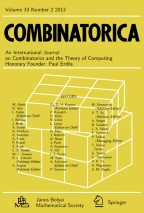Abstract
A familyF of subsets is calledk-dense if there exists ak-element setA such that all 2k of its subsets can be obtained in the formA∩F for someF∈F. Best possible bounds are obtained for the maximum number of sets in notk-densek-partite families. This is a consequence of a new rank formula for inclusion matrices.
Similar content being viewed by others
References
N. Alon: On the density of sets of vectors,Discrete Math. 46 (1983), 199–202.
P. Erdős, C. Ko, andR. Rado: Intersection theorems for systems of finite sets,Quart. J. Math. Oxford(2)12 (1961), 313–320.
P. Frankl: On the trace of finite sets,J. Combin. Th. A. 34 (1983) 41–45.
P. Frankl: An extremal problem for two families of sets,European J. Comb. 3 (1982), 125–127.
P. Frankl, andJ. Pach: On the number of sets in a nullt-design,European J. Comb. 4 (1983), 21–23.
G. Kalai: Intersection patterns of convex sets,Israel J. Math. 48 (1984), 161–174.
N. Sauer: On the density of families of sets,J. Combin. Th. A. 13 (1972), 145–147.
S. Shelah: A combinatorial problem,Pacific. J. Math. 41 (1972), 247–261.
V. N. Vapnik, andA. J. Červonenkis: The uniform convergence of frequencies of the appearance of events to their probabilities, (in Russian),Teor. Veroyatn. Primen. 16 (1971), 264–279.

